
Can't see the region you're looking for? You can find a list of our global locations here
How does that make you feel? Probably slightly nauseous, with a resolution to close the toilet lid each time you flush. It’s a reminder that we can’t always see hazards, that we often put our health and safety in the hands of others, and that others put their health and safety in your hands.
When planning and managing public spaces, we understand that effective, or poor, cleaning has a major impact in three areas; first, how safe people are from slips, second, how hygienic an environment is, particularly for vulnerable people.
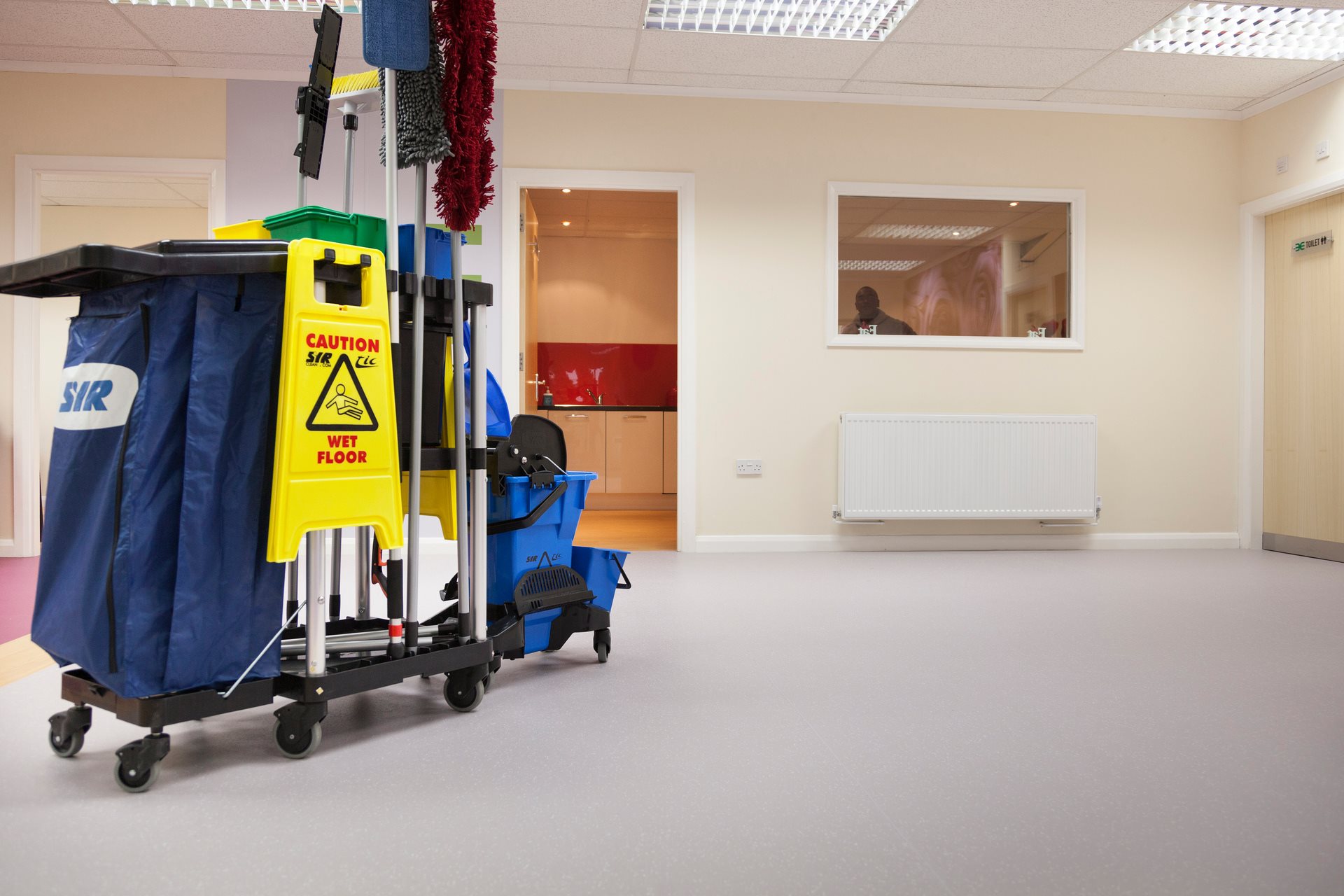
The third area is the perception people have of the space, whether that’s a decision to avoid a restaurant where you’ve been unwell after visiting, to feel unsafe in a healthcare space, or to feel uncomfortable in a work place.
Cleaning is an area we are constantly researching in terms of product development, day to day customer support and resources, such as our downloadable guides. We know it can be a challenging area and it’s not something we’re complacent about.
One area we have looked at is the role of biocides in wall cladding. We know that no current testing proves biocides are effective in reducing Healthcare Associated Infections (HCAIs). Cleaning and effective hand washing are more reliable in preventing bacteria spread.
The good news is that effective cleaning is simple to achieve. We know that how your teams clean depends on what time is available, what equipment and detergents they are able to use, and the size of the spaces they clean.
To help make cleaning as effective as possible, we have guidance on tackling various contaminants, the benefits of different detergents and different cleaning methods, but if you need help to establish a cleaning regime that will work for your space, please get in touch.
¹Best et al. Potential for aerosolizaton of Clostridium difficile after flushing toilets: the role of toilet lids in reducing environmental contamination risk. Journal of Hospital Infection. 2012;80:1-5.
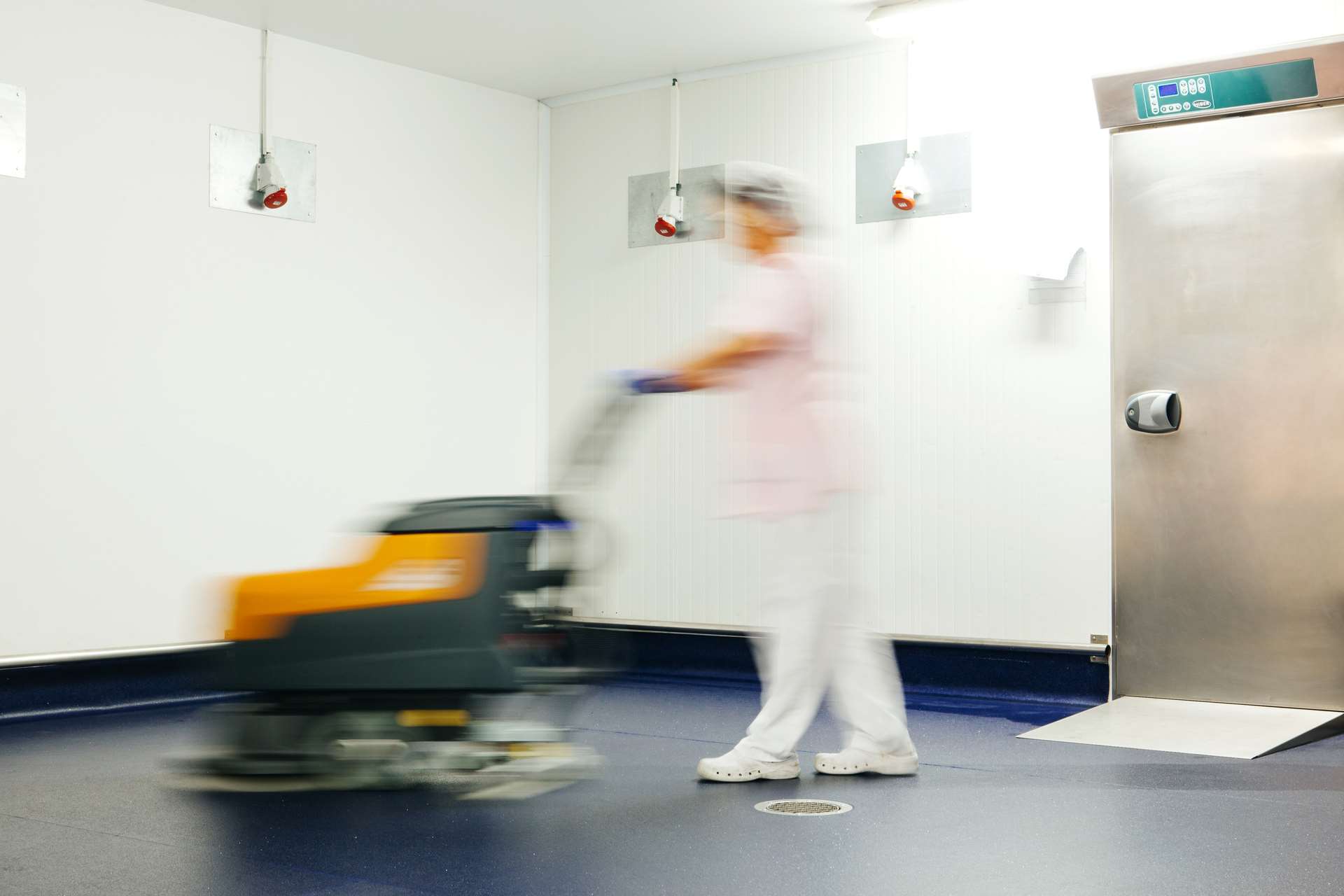
“After taking the brief from the client confirming a bright and contemporary feel was required coupled with the need to have hygienic and easy clean surfaces, it became obvious that the combination of Altro Whiterock White hygienic wall cladding and Altro safety flooring would exactly meet the specification.”
Choosing an Altro vinyl floor and Altro wall cladding reduces cleaning and maintenance time over alternative such as tiles and carpet. In fact, the likelihood of carpet harbouring dirt, germs, hair, skin and other contaminants means it has been banned by the NHS in clinical areas, and is not recommended for food outlets.
Altro walls, doors and floors are designed to be easy to clean. Altro walls and doors can be cleaned by wiping, steam cleaning or power washing – it’s as simple as that. No grout to trap dirt, and impact-resistant, so none of the issues associated with cracked tiles.
Altro resilient floors feature Altro Easyclean technology to make cleaning regimes easier. It gives them additional scratch and abrasion resistance, helping maintain their look. With safety floors, preventing damage to the floor helps ensure they can perform, preventing slips. Altro Whiterock is the only globally Hazard Analysis and Critical Control Points (HACCP) certified PVCu wall sheet, and our walls and floors system is one of the few worldwide to achieve the certification. This means they are approved and can be trusted for use in food preparation areas.
As well as reliable, robust solutions, you have our support before, during and after installation for any technical queries. We have cleaning guides and information here, can offer guidance, or answer questions, over the phone and, where appropriate, can walk the installation with you.
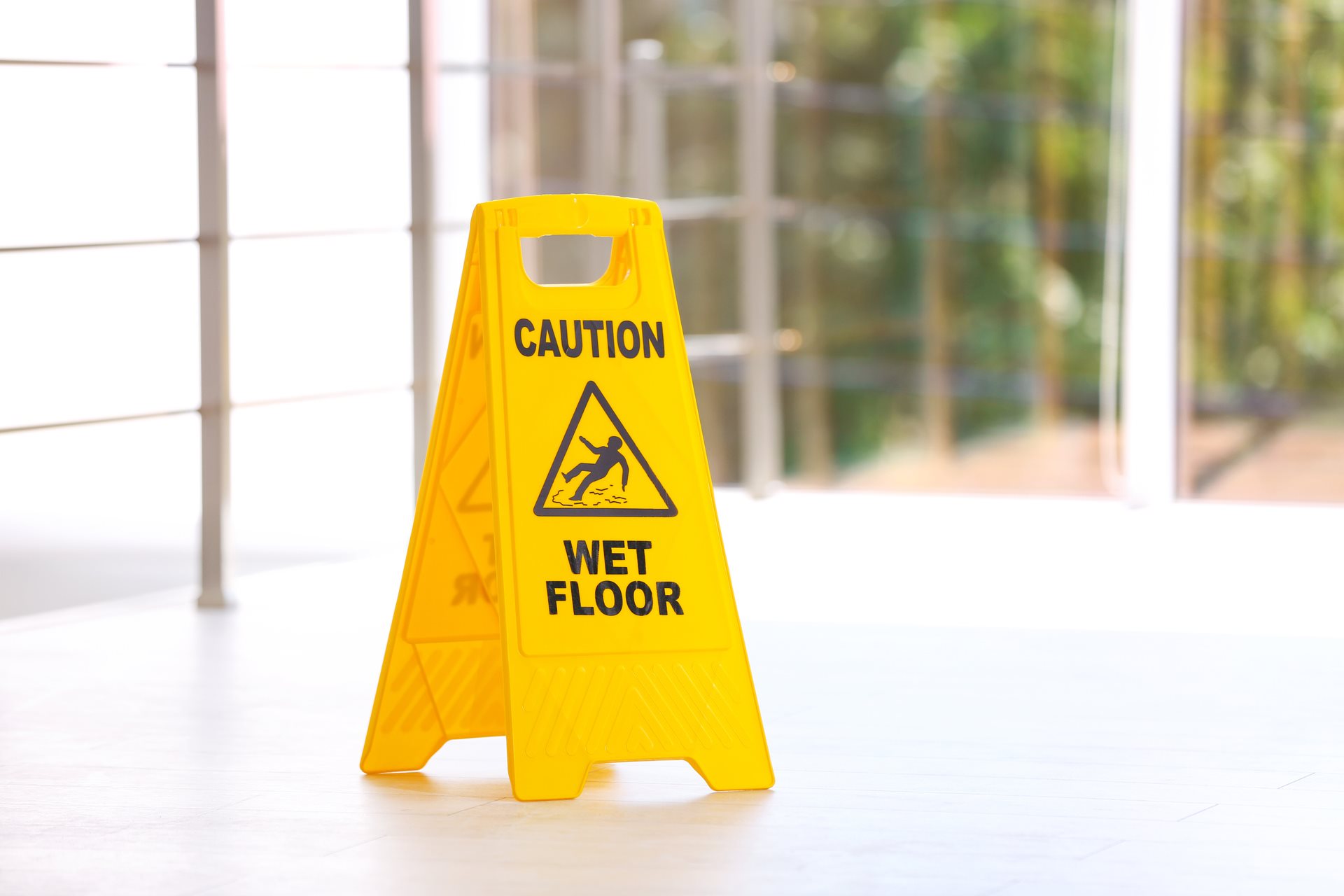
“Hygiene is essential for safety. Unless the floor is easy to clean, it becomes an oily surface and it is less safe to walk on. Therefore it is important that it can be easily cleaned. The fact that we have chosen the same floor again after two years for a larger area is a fantastic endorsement for Altro.”
Correct and thorough cleaning is an essential part of floor maintenance to ensure your slip-resistant floor is kept safe and clean throughout its life. Providing a clean and hygienic environment is one thing, but effective cleaning also has a vital role to play in ensuring your floor continues to perform to the expected standards.
If a risk assessment shows you need a slip-resistant floor, it’s because there is a high, or very high, risk of a slip. The surface profile of slip-resistant flooring ensures that foot and floor connect even when surface contaminants, mud or a spilled hot drink for example, are present. Kept clean, the surface aggregates are of sufficient size and number to break through the contaminants; thereby, reducing the risk of a slip to one in a million. If incorrect cleaning procedures are followed, a hazardous level of dirt and contaminant build-up can accumulate on the surface of the flooring, potentially increasing the risk of a slip to as high as one in two.
We also have step-by-step guides to mechanical, manual and steam cleaning, available to download. These will help keep the floors as safe and attractive as the day they were installed.
Safety is not only about preventing slips. Protecting users from infection risks associated with poor hygiene is obviously best practice generally but in hospitals, and other areas where vulnerable users visit and work, it could be a matter of life or death. This applies to both floors and walls.
“We selected Altro Whiterock to provide the high level of hygiene needed. The wall cladding surface is perfectly even and thus easy to keep clean. When we found out about the product, it was a natural choice for us to make.”
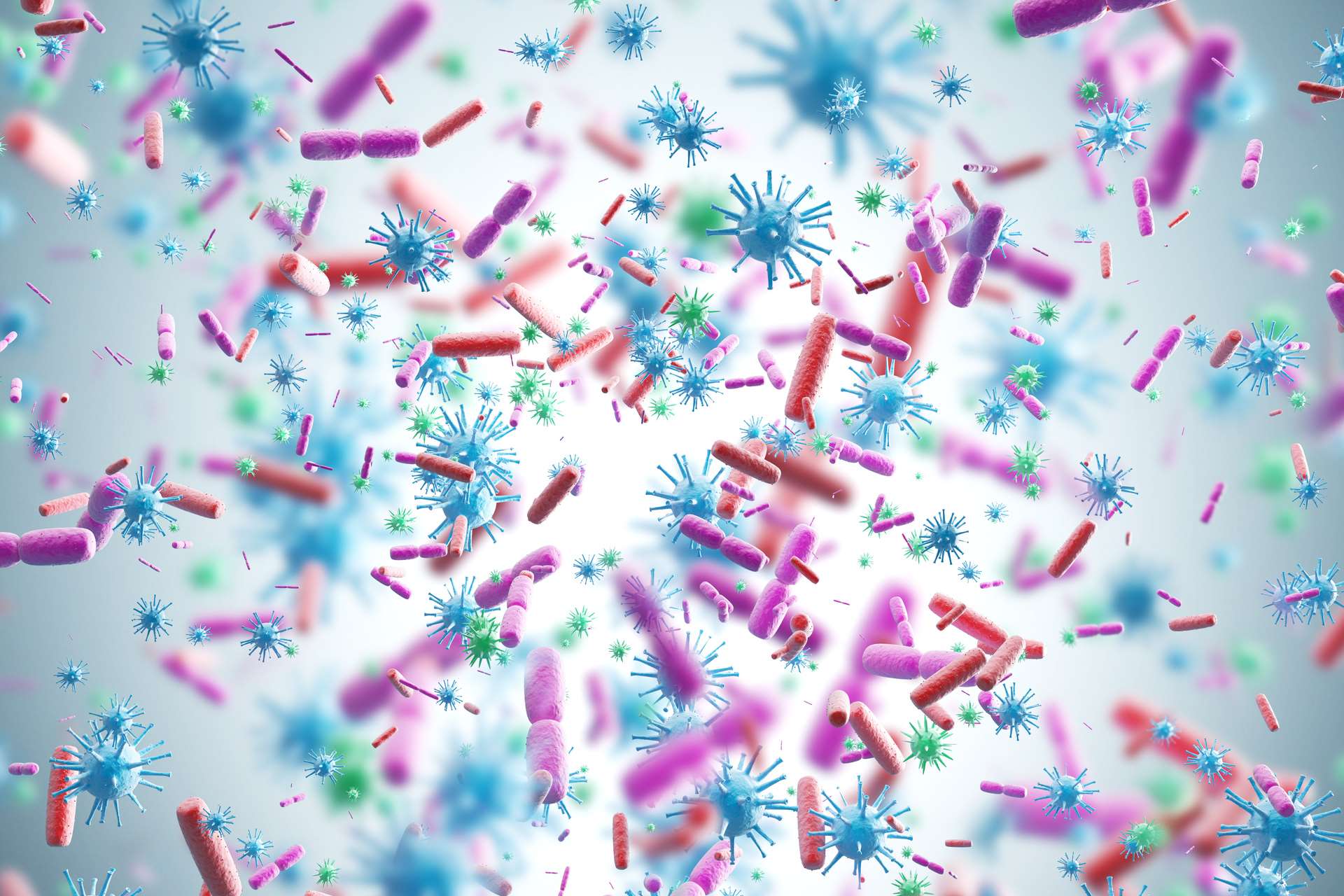
Research undertaken at Leeds University tested the air above public toilets and found that C.Difficile, a germ that can cause us to be violently unwell, can be projected up to 10 inches in the air with every open flush. The germ could be detected all around the toilet, including the floor. Research shows that public toilet floors contain around two million bacteria per square inch, which is five times more than the average toilet seat².
This is just one example of how, without an effective, regular hygiene regime, public spaces pose a risk to our health. The risk is higher for vulnerable people; those who are unwell, have compromised immune systems, the very young and the elderly.
² Best et al. Potential for aerosolizaton of Clostridium difficile after flushing toilets: the role of toilet lids in reducing environmental contamination risk. Journal of Hospital Infection. 2012;80:1-5. https://badgut.org/information-centre/a-z-digestive-topics/germs-in-the-loo/
In hospitals, care homes and in education, cross-contamination is a major cause of illness. It just takes the person preparing food to touch a surface that hasn’t been cleaned properly and germs are transferred.
Food isn’t the only way that germs are passed on, any unhygienic surface that fingers touch can end up being transferred into the mouth, so good hygiene practices are needed in all areas, not only kitchens and food prep. Research into hospital hygiene reveals that 24% of blood sugar monitors and 35% of temperature probe holders failed required hygiene standards³.
³ https://www.cleansweephire.co.uk/2016/07/10-facts-you-didnt-know-about-industrial-cleaning/
For hotels, cafes, bars and restaurants, poor hygiene can impact business both through staff absences and reduced customer numbers, either due to direct experience or word of mouth. There are almost 48 million cases of food-borne illnesses each year that have been linked to ineffective cleaning4.
4 http://www.ipcworldwide.com/us/5-best-practices-for-effectively-cleaning-high-risk-areas/news/
For health and care environments, healthcare-associated infections (HAIs), - illness that wasn’t present at the time of admission, are a major challenge, affecting hundreds of millions of people around the word every year, and up to 7% of patients in developed countries. According to the World Health Organisation (WHO), the impact includes prolonged hospital stays, long-term disability, increased resistance of microorganisms to antimicrobials, massive additional costs for health systems, high costs for patients and their family, and unnecessary deaths. The WHO has identified eight components to support tackling HAIs. Component eight covers built environment, materials and equipment for infection prevention and control in acute healthcare facilities. Its recommendations include that patient care activities take place in a hygienic/clean environment that supports the prevention and control of HAIs5.
5 https://www.who.int/health-topics/infection-prevention-and-control#tab=tab_1
How clean a space is kept can affect those of us simply spending a day at work or school. An incredible 98% of office workers will be affected by a contagious illness in their lifetime, thanks to poor hygiene in the workplace. Nearly a third of workers say their workplace makes allergy symptoms worse, and the related absences cost the UK £7.1 billion every year. Just using a vacuum cleaner regularly could drastically reduce this6. In schools, where poor hand hygiene is more likely, the spread of colds, stomach bugs and other contagious illnesses is an issue affecting both staff and students. In 2017/2018, illness accounted for 55% of school absences, although this is a slight decrease from the two previous academic years7.
6 https://www.cleansweephire.co.uk/2016/07/10-facts-you-didnt-know-about-industrial-cleaning/
7 Department of Education - https://assets.publishing.service.gov.uk/government/uploads/system/uploads/attachment_data/file/787463/Absence_3term_201718_Text.pdf
Choosing Altro resilient floors, hygienic doors or walls, makes keeping a space hygienic, easier. Combining the solutions provides a complete, hygienic system that prevents bacteria and dirt finding hiding places, making cleaning them away easier and giving you peace of mind from top to bottom.
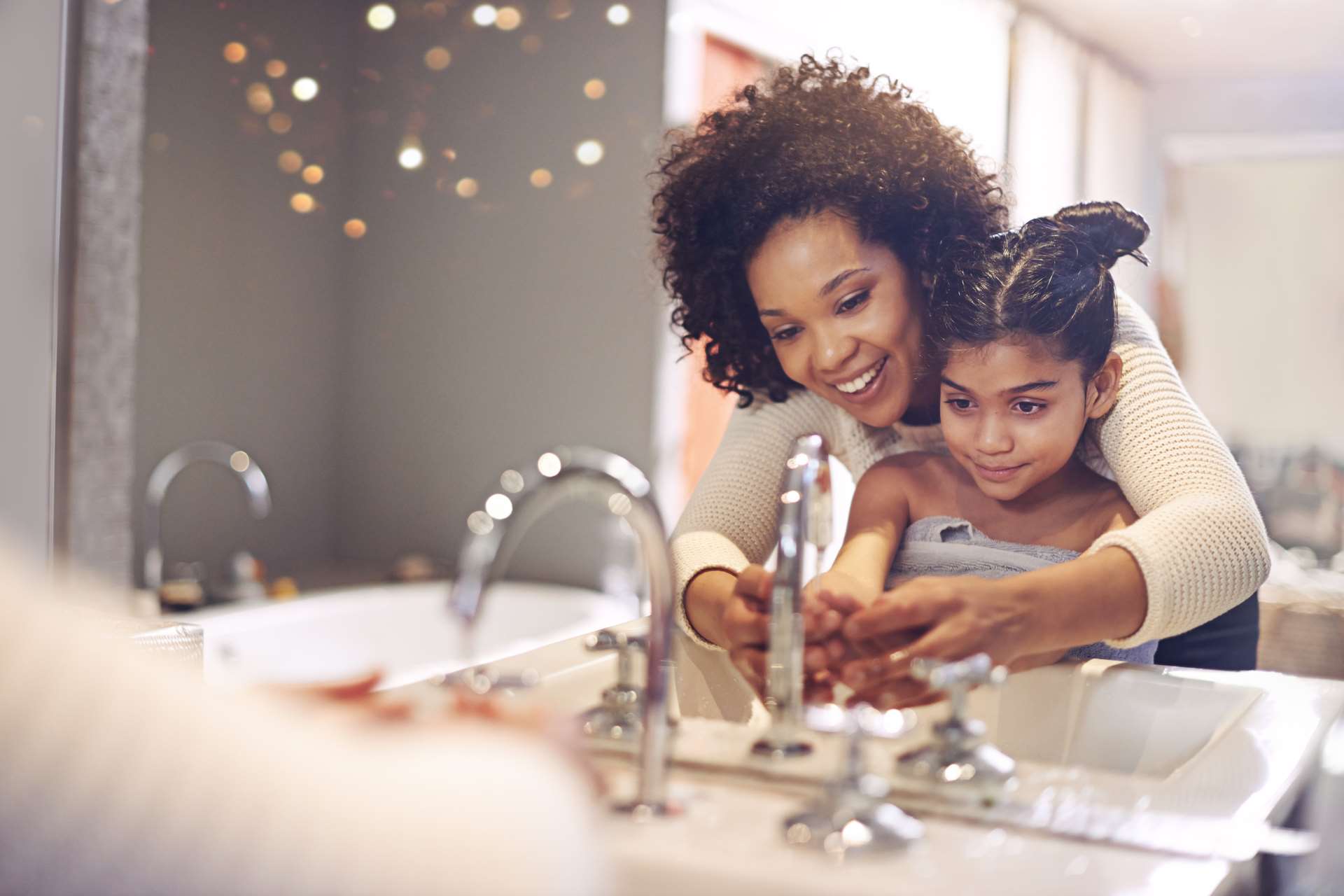
“The teaching and catering staff are amazed at the transformation which has taken place over the summer break. It is such a pleasant environment for the students to enjoy their meal times and is now so much easier to clean and maintain.”
It’s no surprise that humans and animals are wired to be repelled by dirt. It helps keeps us safer from illness, and worse.
As well as poor hygiene making us ill, it has a significant impact on how we see an environment; in fact researchers have found a link between mental health and clean environments. They saw increased levels of stress amongst people in an unclean environment, leading to higher levels of anxiety and depression8.
For businesses trying to attract visitors and diners, the perception of a space impacts whether customers return – and what they tell friends and relatives about it. An astounding 97% of people won’t return to a restaurant that has dirty bathroom facilities9 and a survey of 2000 diners revealed that 91% felt cleanliness is a mark of a good food or hospitality business. The same survey found that four in five people are likely to tell friends or family about a poor hygiene experience10.
There is also an impact for employers, with an unhygienic workplace affecting staff turnover. Research shows that employees lose the desire to be a team player and start job-hunting if in an environment where they breathe in dust, are dodging clutter and are becoming ill from the spread of germs
In addition to being easy to clean, Altro floors and walls are available in a huge variety of shades, including scuff-hiding, darker shades. These are ideal for building entrances and heavy-trafficked areas that can only practically be cleaned after hours. We can help you with guidance on which colours will work well in your space, and which cleaning methods will keep them looking their best.
If you would like to see how different products in different shades could look in your space, take a look at the Altro Insta-space.
8 https://thecleaningladieshms.com/2018/08/27/an-unclean-environment-can-decrease-your-mental-health/
9 YouGov online survey of over 2,000 British adults, conducted by Cannon Hygiene
10 Research conducted by OnePoll for P&G Professional, survey of 2000 people in the UK
Cleaning is easier and more effective if you identify what contaminant is on the floor and can choose the right equipment and detergent to get rid of it.
Material, or matter, is either organic or inorganic.
Organic matter is an ideal breeding ground for bacteria. Steam cleaning or disinfecting is the most effective way to clean.
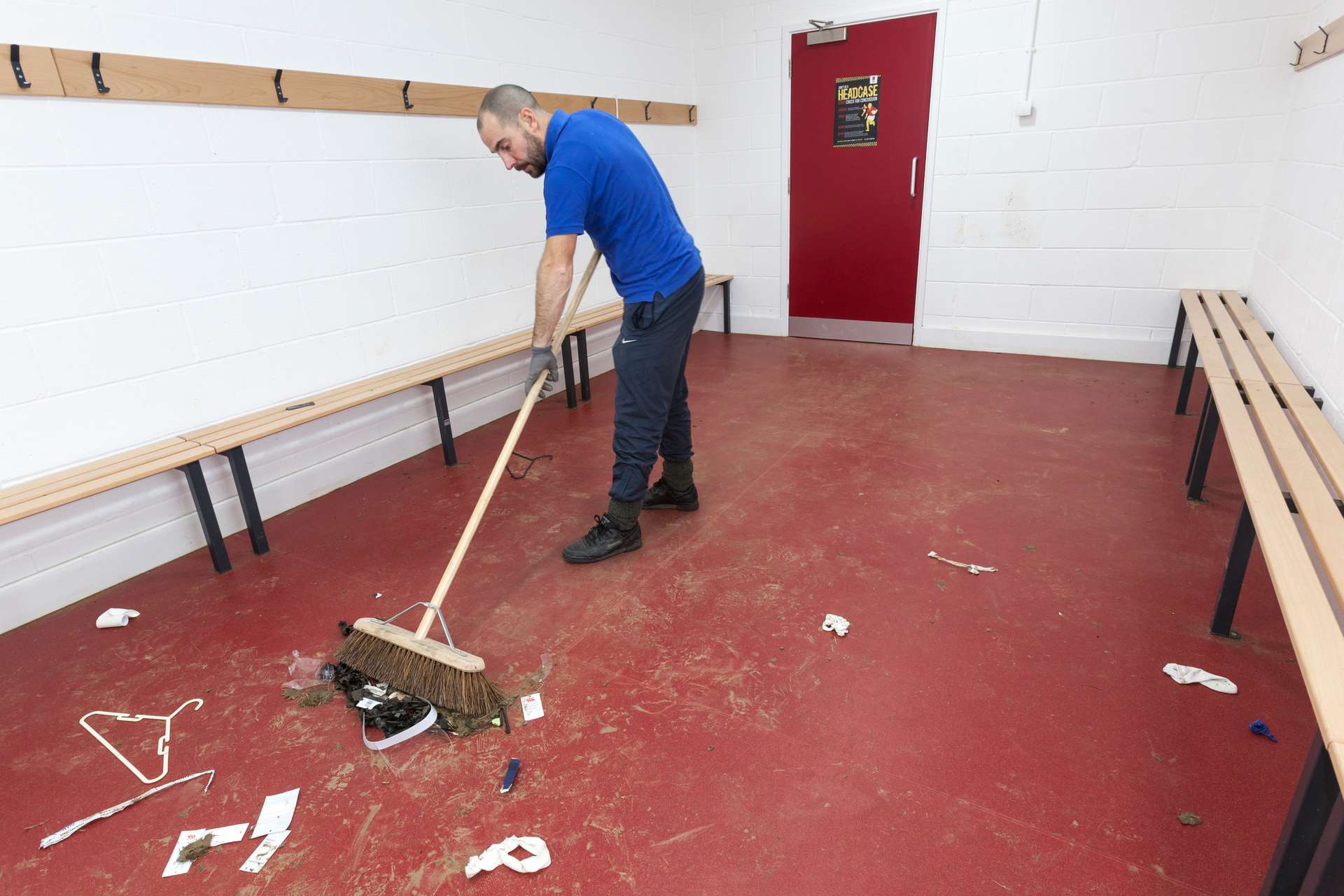
Inorganic contaminants have not been part of a living thing and do not contain carbon. They include glass, salt, rust and brick dust.
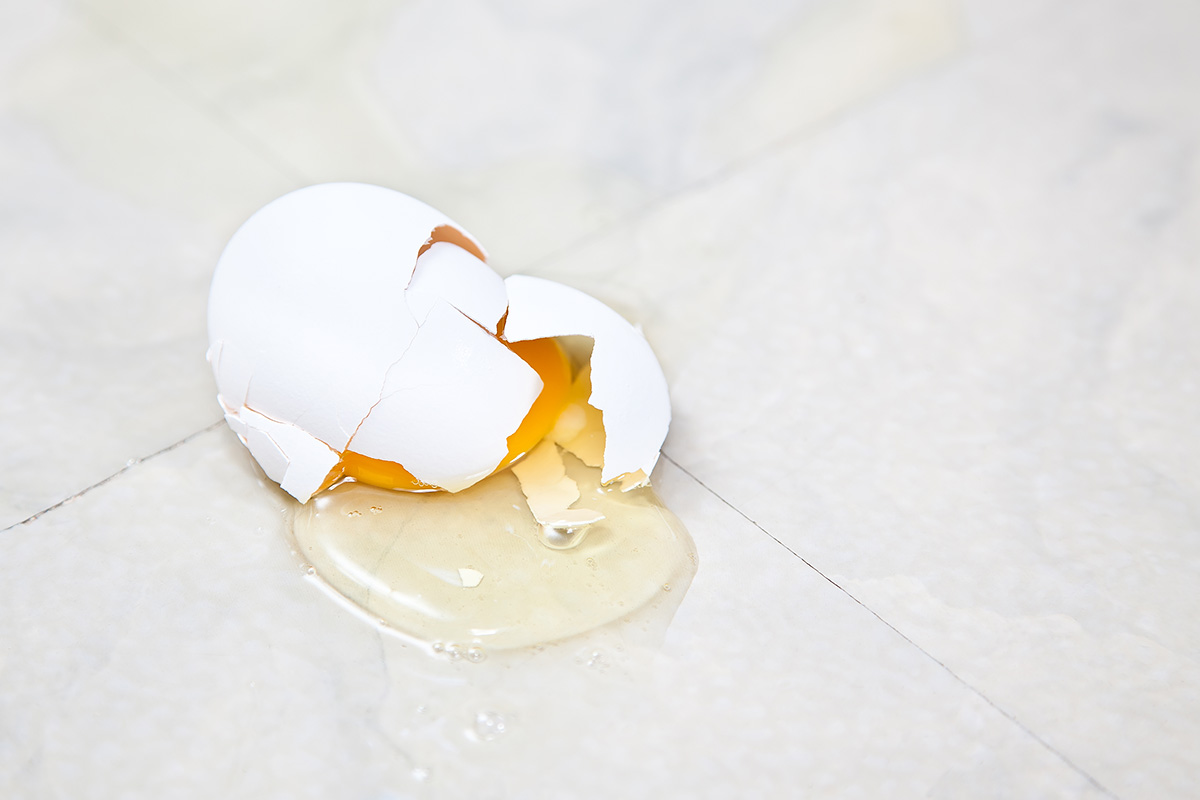
“We work with water, flour and oil which can be difficult to clean but with the new flooring, we’ve significantly reduced the time this takes.”
Whether organic or inorganic, soil behaves in a certain way when you try to clean it:
Soluble contaminants dissolve in water, for example sugar, salt and detergent powder. Because they dissolve, they are generally easy to deal with. It is common where food is sold, prepared or consumed such as cafes, school dining rooms and hospital kitchens.
You are most likely to come across insoluble contaminants; these won’t dissolve in water so will need detergent to remove them. Examples include oil and skin, so they are found in many environments, including kitchens and wet environments.
Insoluble soil can be greasy or particulate:
Greasy contaminants stick to surfaces and smear when touched. Examples are oil, fat and grease. This is likely anywhere food is present but also, as vehicles leave behind oil and grease, it will regularly be carried on foot into communal areas.
Particulate contaminants are powdery, examples being sand, skin, washing powder and broken fibres, so they will be found in a wide range of environments.
It is very likely that you will find greasy and particulate contaminants together as the powdery soil will stick to any grease it comes into contact with.
Abrasive soil may scratch a surface, for example, glass.
Stubborn/tacky contaminants may stick to a surface, for example, syrup, wax or glue.
So, materials belong to more than one of the categories, as one is what it is made of and the other is how it behaves: salt spilt from a container is an inorganic, particulate soil which can be swept, or vacuumed, up; salt spilt onto a wet surface is an inorganic, soluble soil that can be washed away.
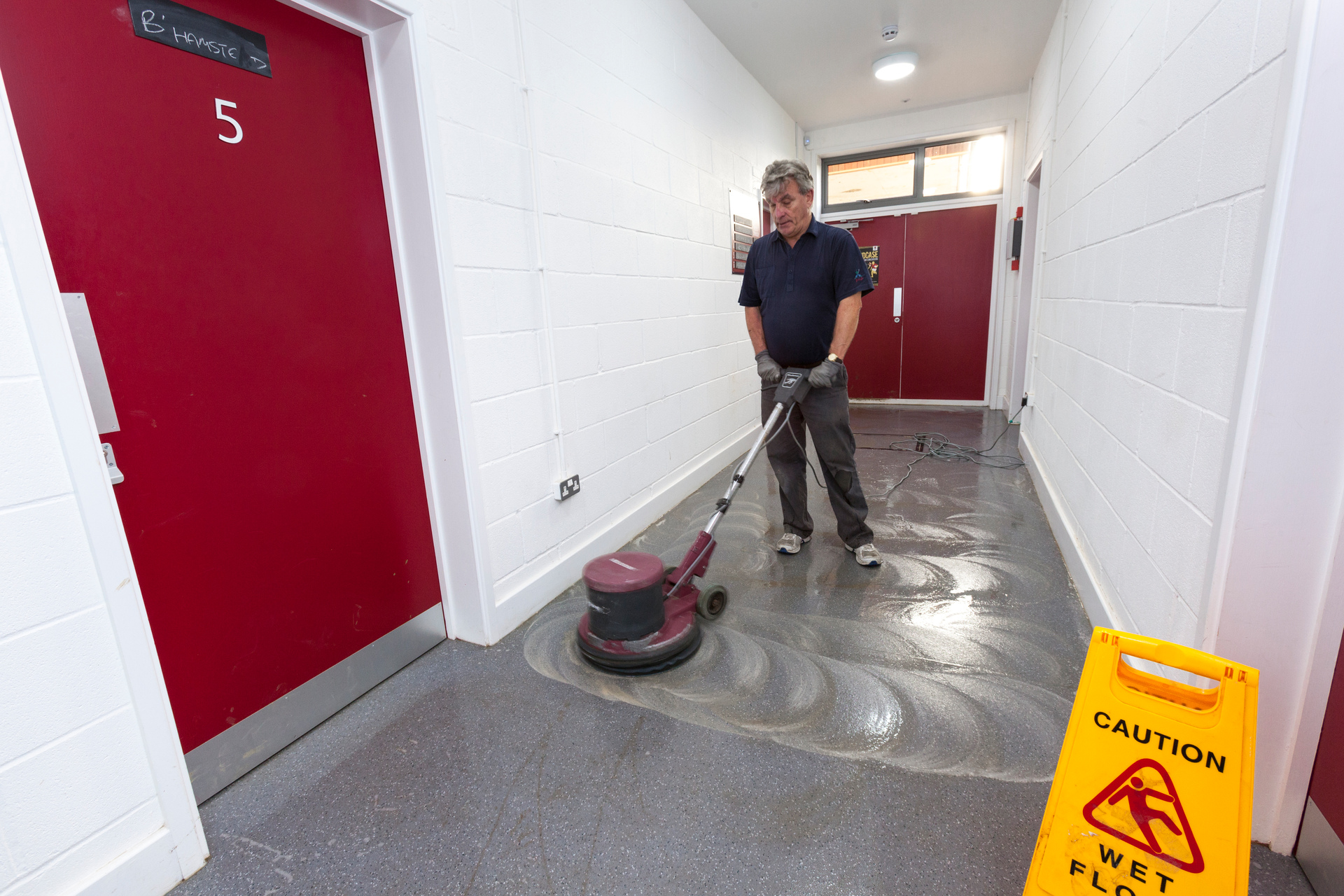
Using the right equipment in the right order to clean your floors will help ensure cleaning is effective. While that sounds like a lengthy process, it actually should reduce the time spent.
Choosing the right kit isn’t just about the size and type of room, it’s about the right equipment for the contaminants you are dealing with.
Our top tip is to maintain equipment and prevent transferring dirt and bacteria onto the floor, it’s vital to clean it after each use. This needs to be part of the overall regime.
Before selecting your cleaning method, the first step is to sweep or vacuum up particulate and/or abrasive contaminants.
Manual cleaning: using a mop, twin bucket and/or deck scrubber. This is most effective on day to day, walked-in soil, and when cleaning needs to be done immediately, for example, where there is a spillage in a restaurant.
Mechanical cleaning: using a cleaning machine. As the machine scrubs the floor evenly and with pressure, it cleans stubborn and greasy soil very well. If space and availability allow, mechanical cleaning is preferable to manual cleaning as this will help reduce the amount of time spent.
Steam cleaning: using a mechanical steam cleaner. This is very effective for cleaning organic soil as the temperature of the steam helps remove most bacteria. It is ideal for areas where hygiene is important such as hospital wards, bathrooms and kitchens.
Each method is effective for cleaning both soluble and insoluble soils. The choice will depend more on whether that soil is stubborn/tacky or greasy and whether hygiene is of paramount importance in the area being cleaned, for example, an operating theatre.
“I think the floors are super easy to clean. I have worked in many kitchens in my career, and this is the first time I’ve worked on a floor that is so easy to clean. With a tiled floor, I often experienced having to scrub for half an hour to get the floor clean.”
Choosing the right detergent for the contaminants you are tackling is the best way to clean effectively.
The properties within detergent lift and hold contaminants so that they aren’t redistributed during cleaning. It is important to leave detergent on the floor, according to the manufacturer’s instructions, to give it time to do this.
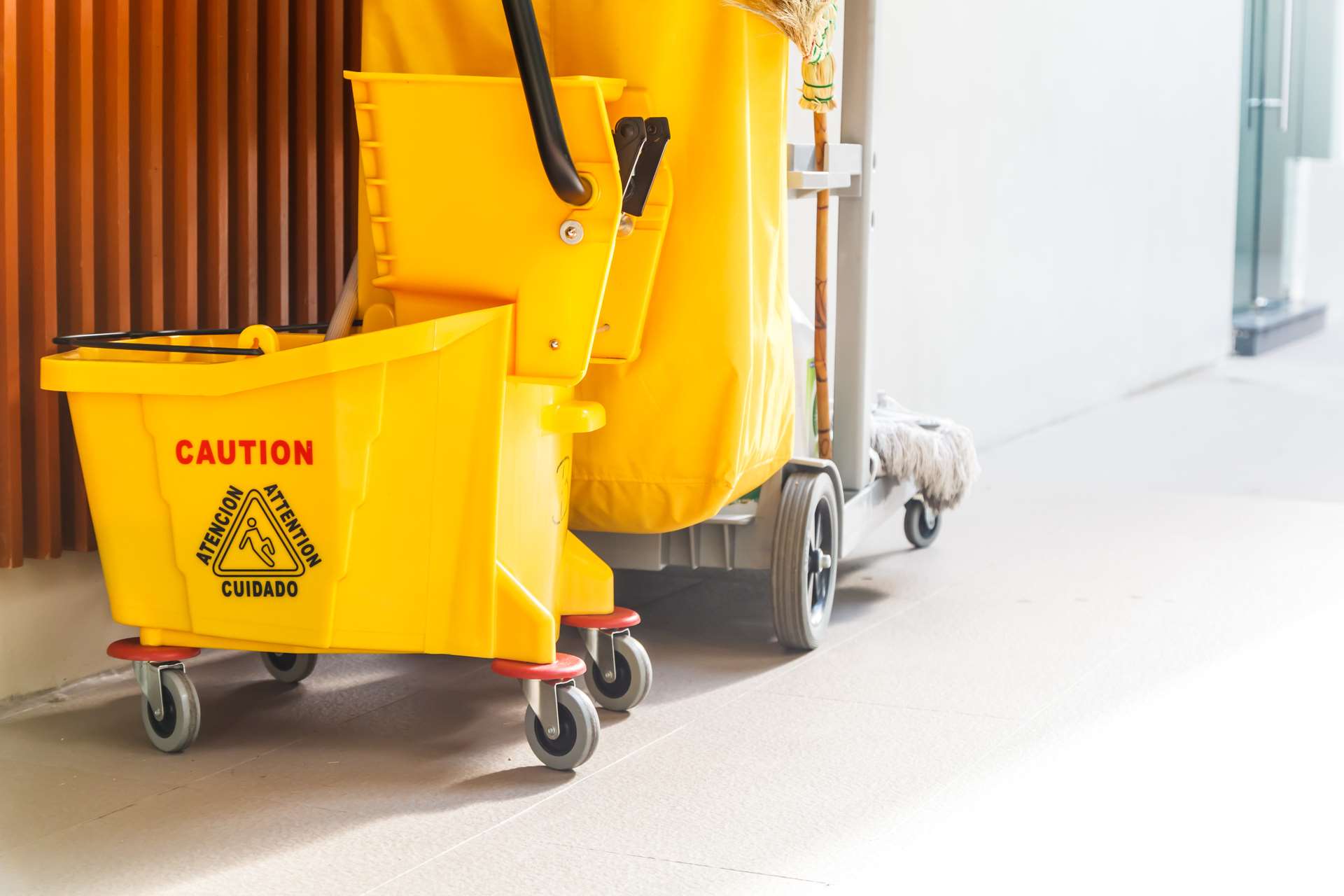
What makes one detergent different from another is how acidic or alkaline it is. This is measured using the pH scale which runs from pH0 (most acidic) to pH14 (most alkaline).
We appreciate that if cleaning multiple areas your team may only be able to use one type of detergent. If that’s the case, a neutral detergent (pH7) is effective on everyday levels of contaminants while a combined detergent/cleaning sanitiser is good for areas where food or human waste is common, as it reduces bacteria growth.
Our top tip is to dilute according to the manufacturer’s instructions. Not enough detergent means a less effective clean. Too much detergent can leave a film on the floor that reduces slip-resistance and attracts contaminants, encouraging bacteria growth. It is also a common cause of staining/discolouration and problems associated with chemical damage such as shrinkage.
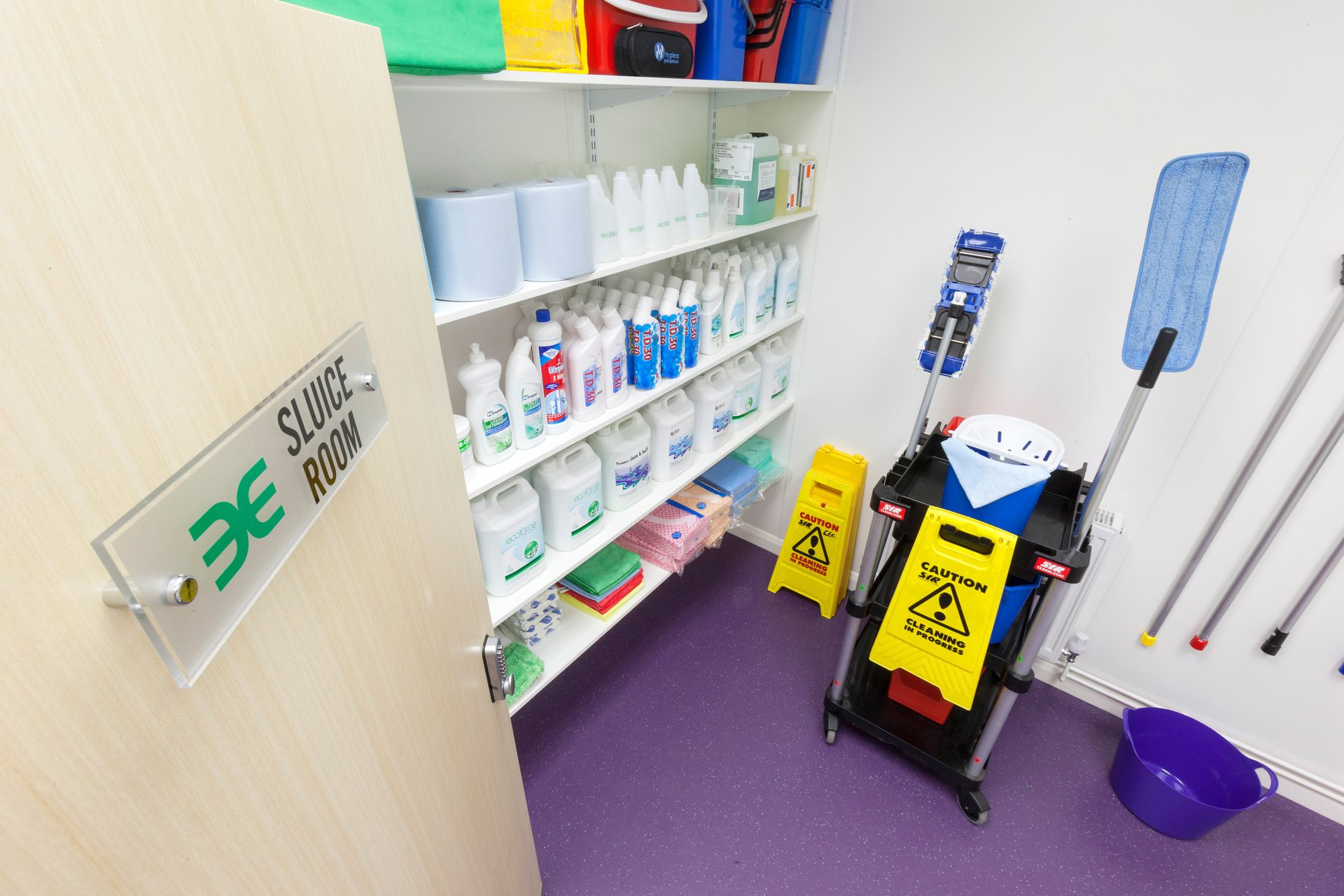
“People return again and again to the apartment and they have told us they love the new style, and are so impressed with how chic it looks. We are also finding the flooring easy to clean and very durable.”
Here’s our quick guide to detergents:
Alkaline: a detergent measuring above pH9.5 works by dissolving fat and emulsifying soils. So an alkaline detergent such as AltroClean 44 is ideal for greasy and organic soils. The more alkaline the detergent, the more effective for removing grease but the more corrosive it becomes, which can damage paintwork so thorough rinsing is very important.
Acidic: a detergent measuring less than pH5 is acidic and a good option for inorganic soils such as lime scale.
Neutral: neutral detergents (pH7) are less aggressive and contain fewer chemicals. This makes them more user-friendly, with less environmental impact. They are effective on everyday levels of contamination across a range of surfaces, but will not cope as well with heavy soiling. They are also not as effective for greasy dirt and fats where an alkaline detergent would be more suitable.
Combined disinfectant detergent/cleaning sanitiser: when cleaning organic soil such as food or human waste, this reduces bacteria growth, which is important when maintaining hygienic standards.
Checklist for specifying Altro walls, floors and doors that will support your cleaning goals:
“It feels safe to walk on the floor. It is also easy to clean. We clean the floor and wipe the water with a rubber scraper.”
“The care and attention to cleaning, and the cleaning methods that I spoke about in this interview, haven’t changed – although their importance is now clearer to many more of us. However, to prepare for people returning to work and to places of learning, I would recommend a two-stage cleaning process. That means cleaning with a detergent to remove the soil that that we can see, followed by disinfecting with a reputable product - 1000 ppm chlorine is recommended to get on top of surface contamination, which is what can’t be seen with the naked eye. The two-stage process will ensure a thorough and effective clean, and will also reassure returning staff and visitors. I’ve always recommended periodic detailed-cleaning – unfortunately it’s not always done - but I think that attitudes will, rightly, change now and this type of regular clean will become part of scheduled maintenance.”